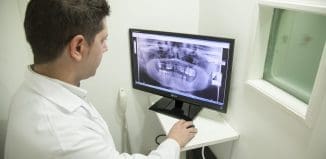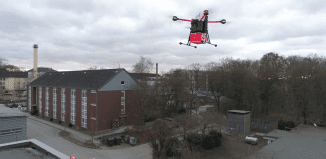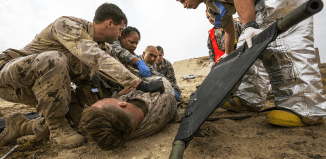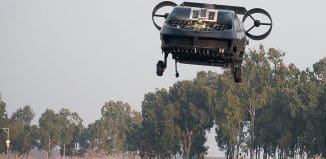A Battlefield without Blood – Medical Simulation
This post is also available in:  עברית (Hebrew)
עברית (Hebrew)
By Joe Charlaff
The air is filled with smoke. The rattle of gunfire echoes all around. The sound of hovering helicopters overhead. Medical teams race through semi darkness to render assistance in response to screaming injured soldiers.

The battle is not real, but a simulated one. Doctors and paramedics are put through their paces judging how they perform under simulated battlefield conditions.
The action takes place at the Israel Defense Force’s (IDF) Medical Simulation Center at Tzrifin. It is the largest army training base in the entire country situated near Tel Aviv. Army medical teams from all over the country come to train at this facility throughout the year.
Doctors and paramedics are put through a progressive structured drill beginning with reinforcing basic skills, including managing an airway and ventilating a patient. Lifelike mannequins, incorporating a built-in mechanism of simulated breathing is used. By remote control an instructor can regulate the breathing rate enabling the medic to check the “patient’s” breathing rate independently.
The instructor is also able to control the movement of jaws and make it difficult for the medic to open the mouth. This is the case when an airway is obstructed from within resulting from a situation where a patient had inhaled smoke. A device called the Oxymeter can monitor the saturation of oxygen in the bloodstream as well as the pulse when connected to a patient.
Over the past decade mannequins that breathe, talk, blink, and respond like real patients have allowed a growing number of doctors and paramedics worldwide to improve their skills risk-free.
Doctors are given an opportunity to carry out procedures on the mannequins such as endotracheal intubation in the event of a thoracic injury.
Communication is as important as medical skills. A doctor and his paramedics team needs to focus on seamless teamwork. A paramedic needs to learn how to coordinate with a doctor and the doctor needs to know the strengths and weaknesses of each team member at this stage, and not encounter problems later on the real battlefield.
Doctors have personal working styles, and once this stage has been worked out satisfactorily the team is moved to the next room where they are presented with a scenario and then instructed to start working on a “patient.” At this stage any remaining communication problems are resolved.
iHLS – Israel Homeland Security

The final stage is a multiple casualty battle scenario which is staged in a special room created to look and feel like a battlefield.
Wounded soldiers (lifelike mannequins) lie on the ground, camouflage netting hangs down adding to the authenticity, and special effects emanate from mounted speakers: sounds of artillery fire, the staccato crackle of rifles, helicopters hovering, and the screams of the wounded. Smoke is introduced into the room for additional effect.
The aim of this stage is to test the nerves and efficacy of the medics, testing their ability to work under pressure under simulated battle conditions, and not in a clean and quiet environment.
The teams are generally composed of a doctor and paramedics.A senior paramedic supervises the entire procedure according to standard army procedure. Triage determines which patients should be treated in the field and which should be evacuated immediately.
The “wounded” soldiers are wired to the control room where instructors are able to produce screaming via hidden speakers in the mannequin, as well as control their vital signs.
Instructors in the control room using video cameras focus on every aspect of the exercise, and film the entire operation for debriefing purposes afterwards.
The mannequins used in this drill are a more sophisticated version of the basic ones used in the first stage. They can “speak” and doctors are able listen to the breathing and detect the presence of a thoracic injury. The patient’s pulse, blood pressure and other vital signs are displayed on a monitor outside for the benefit of the medics.
Afterwards, in the debriefing room the performance of each participant, which has been videotaped from different angles, is reviewed and critiqued.
In addition, the IDF deploys special units who are trained to deal with chemical weapon attacks. They train at the center using special suits, masks and equipment together with medical units who carry the appropriate medication for victims of chemical attacks.
The center has a world wide reputation and army representatives from the US, France, Italy, and also from the East, come to the center to participate in special training courses. The benefits of medical simulation include training in a safe environment, proactive battle exposure for the trainee and team work, followed by extensive debriefing sessions. The IDF Medical Corps is doing it’s utmost to provide the best emergency treatment to soldiers on the battlefield.






























